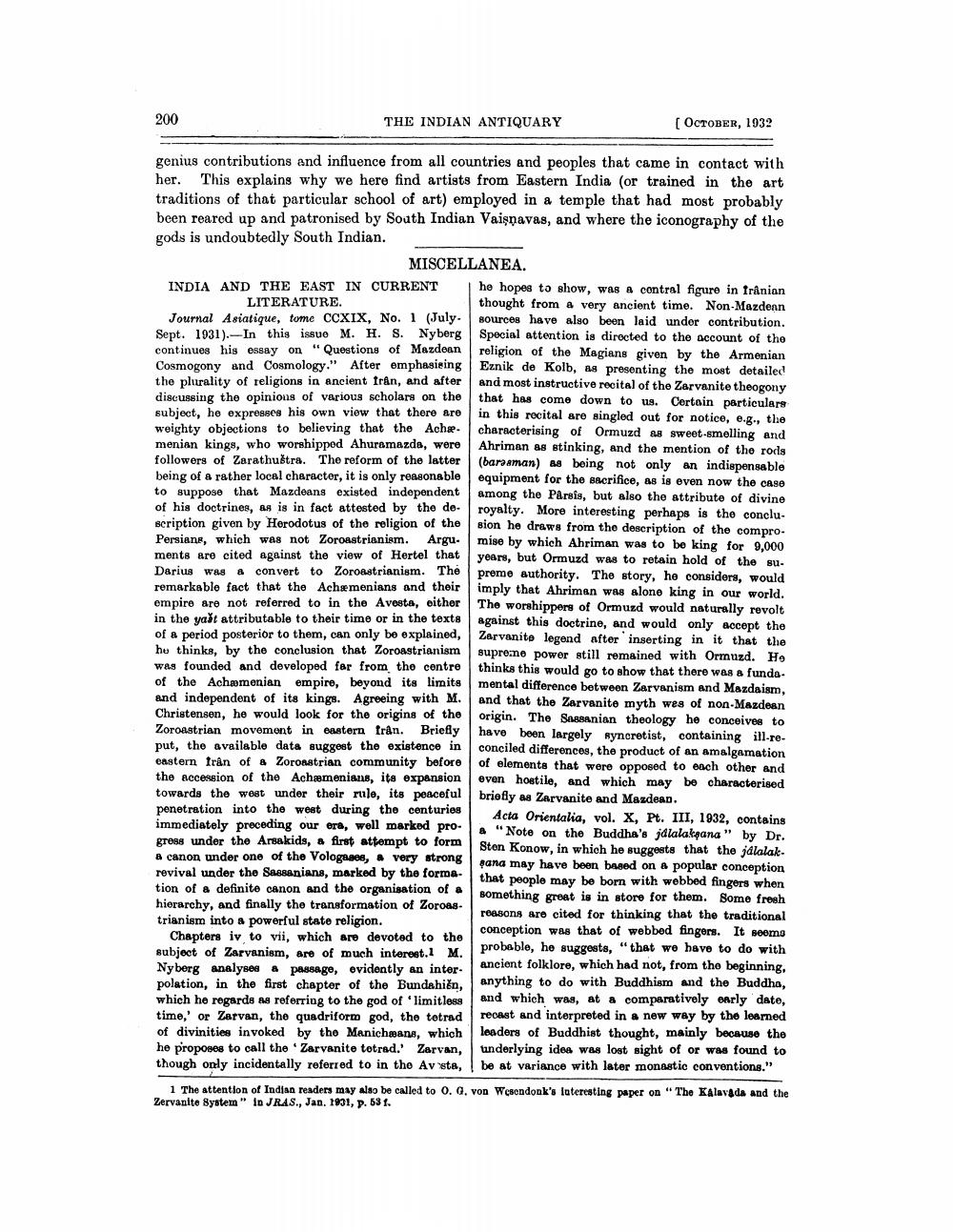________________
200
THE INDIAN ANTIQUARY
genius contributions and influence from all countries and peoples that came in contact with her. This explains why we here find artists from Eastern India (or trained in the art traditions of that particular school of art) employed in a temple that had most probably been reared up and patronised by South Indian Vaisnavas, and where the iconography of the gods is undoubtedly South Indian.
MISCELLANEA.
INDIA AND THE EAST IN CURRENT LITERATURE.
Journal Asiatique, tome CCXIX, No. 1 (July. Sept. 1931). In this issue M. H. S. Nyberg continues his essay on "Questions of Mazdean Cosmogony and Cosmology." After emphasising the plurality of religions in ancient från, and after discussing the opinions of various scholars on the subject, he expresses his own view that there are weighty objections to believing that the Achsmenian kings, who worshipped Ahuramazda, were followers of Zarathustra. The reform of the latter being of a rather local character, it is only reasonable to suppose that Mazdeans existed independent of his doctrines, as is in fact attested by the description given by Herodotus of the religion of the Persians, which was not Zoroastrianism. Arguments are cited against the view of Hertel that Darius was a convert to Zoroastrianism. The remarkable fact that the Achæmenians and their empire are not referred to in the Avesta, either in the yast attributable to their time or in the texts of a period posterior to them, can only be explained, he thinks, by the conclusion that Zoroastrianism was founded and developed far from the centre of the Achæmenian empire, beyond its limits and independent of its kings. Agreeing with M. Christensen, he would look for the origins of the Zoroastrian movement in eastern från. Briefly put, the available data suggest the existence in eastern från of a Zoroastrian community before the accession of the Achæmenians, its expansion towards the west under their rule, its peaceful penetration into the west during the centuries immediately preceding our era, well marked progress under the Arsakids, a first attempt to form a canon under one of the Vologases, a very strong revival under the Sassanians, marked by the formation of a definite canon and the organisation of a hierarchy, and finally the transformation of Zoroastrianism into a powerful state religion.
[OCTOBER, 1932
Chapters iv to vii, which are devoted to the subject of Zarvanism, are of much interest.1 M. Nyberg analyses a passage, evidently an interpolation, in the first chapter of the Bundahien, which he regards as referring to the god of 'limitless time,' or Zarvan, the quadriform god, the tetrad of divinities invoked by the Manichæans, which he proposes to call the Zarvanite tetrad.' Zarvan, though only incidentally referred to in the Av sta,
he hopes to show, was a contral figure in Iranian thought from a very ancient time. Non-Mazdenn sources have also been laid under contribution. Special attention is directed to the account of the religion of the Magians given by the Armenian Eznik de Kolb, as presenting the most detailed and most instructive recital of the Zarvanite theogony that has come down to us. Certain particulars in this recital are singled out for notice, e.g., the characterising of Ormuzd as sweet-smelling and Ahriman as stinking, and the mention of the rods (baraaman) as being not only an indispensable equipment for the sacrifice, as is even now the case among the Pârsis, but also the attribute of divine royalty. More interesting perhaps is the conclusion he draws from the description of the compromise by which Ahriman was to be king for 9,000 years, but Ormuzd was to retain hold of the supreme authority. The story, he considers, would imply that Ahriman was alone king in our world. The worshippers of Ormuzd would naturally revolt against this doctrine, and would only accept the Zarvanite legend after inserting in it that the supreme power still remained with Ormuzd. He thinks this would go to show that there was a fundamental difference between Zarvanism and Mazdaism, and that the Zarvanite myth wes of non-Mazdean origin. The Sassanian theology he conceives to have been largely syncretist, containing ill-reconciled differences, the product of an amalgamation of elements that were opposed to each other and even hostile, and which may be characterised briefly as Zarvanite and Mazdean.
Acta Orientalia, vol. X, Pt. III, 1932, contains a "Note on the Buddha's jalalakeana" by Dr. Sten Konow, in which he suggests that the jalalaksana may have been based on a popular conception that people may be born with webbed fingers when something great is in store for them. Some fresh reasons are cited for thinking that the traditional conception was that of webbed fingers. It seems probable, he suggests, "that we have to do with ancient folklore, which had not, from the beginning, anything to do with Buddhism and the Buddha, and which was, at a comparatively early date, recast and interpreted in a new way by the learned leaders of Buddhist thought, mainly because the underlying idea was lost sight of or was found to be at variance with later monastic conventions."
1 The attention of Indian readers may also be called to 0. G. von Wesendonk's luteresting paper on "The Kalavada and the Zervanite System" in JRAS., Jan. 1931, p. 53 f.




